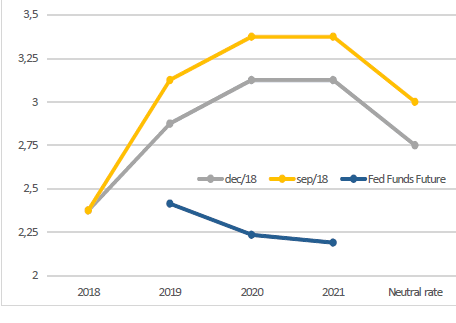- Fed leaves policy rate unchanged at 2.25%-2.50%; BUT…
- … makes a dovish U-turn. Patience is the new code.
- The need for further gradual rate hikes is no longer mentioned
- The balance sheet will remain bigger than expected until now
- The new ‘Powell put’ propels risky assets
The Fed as expected left its left the target range for Fed fund rate unchanged at 2.25%-2.50%. However, they made some key changes to their policy statement. In a separate statement regarding the monetary policy implementation and monetary policy normalisation, the Fed indicated that it could alter the current run-off of its balance sheet. At the press conference, Fed chairman Powell in several ways said that the Fed can remain patient on any further changes to monetary policy.
The Fed didn’t change that much in int’s monetary policy statement regarding its assessment on the economy or on inflation. They repeated that the labour market has continued to strengthen and that economic activity has been raising at a ‘solid’ (instead of strong) pace. The Fed’s assessment on inflation was also little changed. On a 12- month basis, inflation remains near 2%, but the US central bank acknowledged that market-based measures of inflation compensation have moved lower in recent months. Important: the Fed omitted the sentence from the December policy statement that it judges that some further gradual increases in the policy rate will be consistent with reaching its target. The Fed also removed the assessment that risk to the economic outlook are roughly balanced, acknowledging doubt about the (near term) future. The Fed paragraph did repeat thath future changes in the target range will depend on a wide range of incoming information.
In a separate statement regarding monetary policy implementation and balance sheet normalisation, the Fed indicated to continue to implement monetary policy in a regime of ample supply in which the Federal funds rate (and other administered interest rates) will remain the key policy instruments. At the same time, the Fed signals that it would be prepared to adjust the details of completing balance sheet normalisation in the light of recent financial and economic developments. In this respect, the committee would be prepared altering the composition and the size of the balance sheet if future economic conditions would warrant to do so.
Key takeaways
The Fed clearly turned much softer on its policy intentions going forward even as its assessment on the economy hasn’t profoundly changed. Powell said that the US economy is still in a good place, but that some crosscurrents and conflicting signals have interfered. Brexit, the US government shutdown and the US-China trade tensions are among those crosscurrents.
The Fed doesn’t explictely say that the monetary tightening cycle has come to end. Strong incoming data might still decide otherwise. However, the statement at least suggests that there is also a chance that the monetary cycle is up for a long pause, allowing the Fed to monitor economic and other developments. It this framework it is even not excluded that the next move might be a rate cut.
The Fed didn’t give real specific hints on the timing of a possible slowdown in the roll-off of the balance sheet or on its size once the normalisation process will be finished. However, Powell clearly hinted that ‘tapering’ of the balance sheet roll-off might comes sooner than was expected until now and that the size of the balance sheet will be probably reamin substantially higher than expected at the start of the run-off
Bridging the gap with markets
There remained quite a big discrepancy after the December policy meeting between the Fed guidance (as mirrored by the Fed dots and the communication after the policy decision) and market pricing. Yesterday’s ‘wait-and-see’ and patience, doesn’t give an explicit direction on the next Fed move. However, it is reasonable to conclude that the Fed has made a big step in the direction of recent market pricing. Market now see a big chance of the Fed leaving rates unchanged untill the end of the year, with a slightly higher probability of a rate cut rather than a rate hike toward the end of 2019. Yesterday’s comments suggest the Fed is sidelined at least until and probably beyond the Summer.
Market moves on the Fed policy statement and on Powell’s comments were very substantial. The yield curve bull steepened with the 2-yr (2.51%, -6.5 bps) and the 5-yr (2.48%, -6,2 bps) outperforming. The 10-yr yield declined 3.3bps. The 30-yr yield shed less than 1 bp. The moves in the major USD cross rates were significant, but not excessive. The trade-weighted dollar declined slightly more than 0.5% and closed the session in the 0.9540 area. EUR/USD tested the 1.15 area but closed at 1.1480. USD/JPY dropped to the 109 area, compared to an intraday peak in the 109.75 area. The prospect of a more accommodative Fed policy (a new ‘Powell put’?!) propelled US equity markets, with the major US indices rising 1.55% (S&P) to 2.20 % (Nasdaq)















